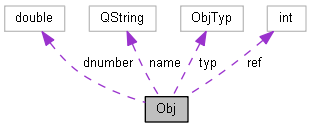|
My Project
|
symbol class to organize complex us er imput More...
#include <fitmodel.h>

Public Member Functions | |
| Obj (QString name, ObjTyp typ, int i) | |
| create am onject of specific type, with reference i fitmodel::rData | |
| Obj (QString name, double i) | |
| creates constant number, value i | |
| Obj (QString name) | |
| creates without functionality | |
| bool | operator== (QString name) |
| to compare Obj with each other | |
| bool | operator== (Obj o) |
| to compare Obj with each other | |
| bool | operator< (const Obj o2) const |
Public Attributes | |
| double | dnumber |
| float value if it is const. number | |
| QString | name |
| declaration name | |
| ObjTyp | typ |
| specifies how to evaluate this Obj | |
| int | ref |
| index to fitmodel::rData it belongs to | |
symbol class to organize complex us er imput
user imput is done by symbols only. That means on every place where finally a number is expected the user states a symbol which might be resolved to a number, map, function or fit parameter. An Object knows its type due to the place of declaration (i.g. function objects are declaredin the FUNCTIONS block only). Using the fitmodel::eval() function the the corresponding number to an object can be returned.
 1.8.5
1.8.5